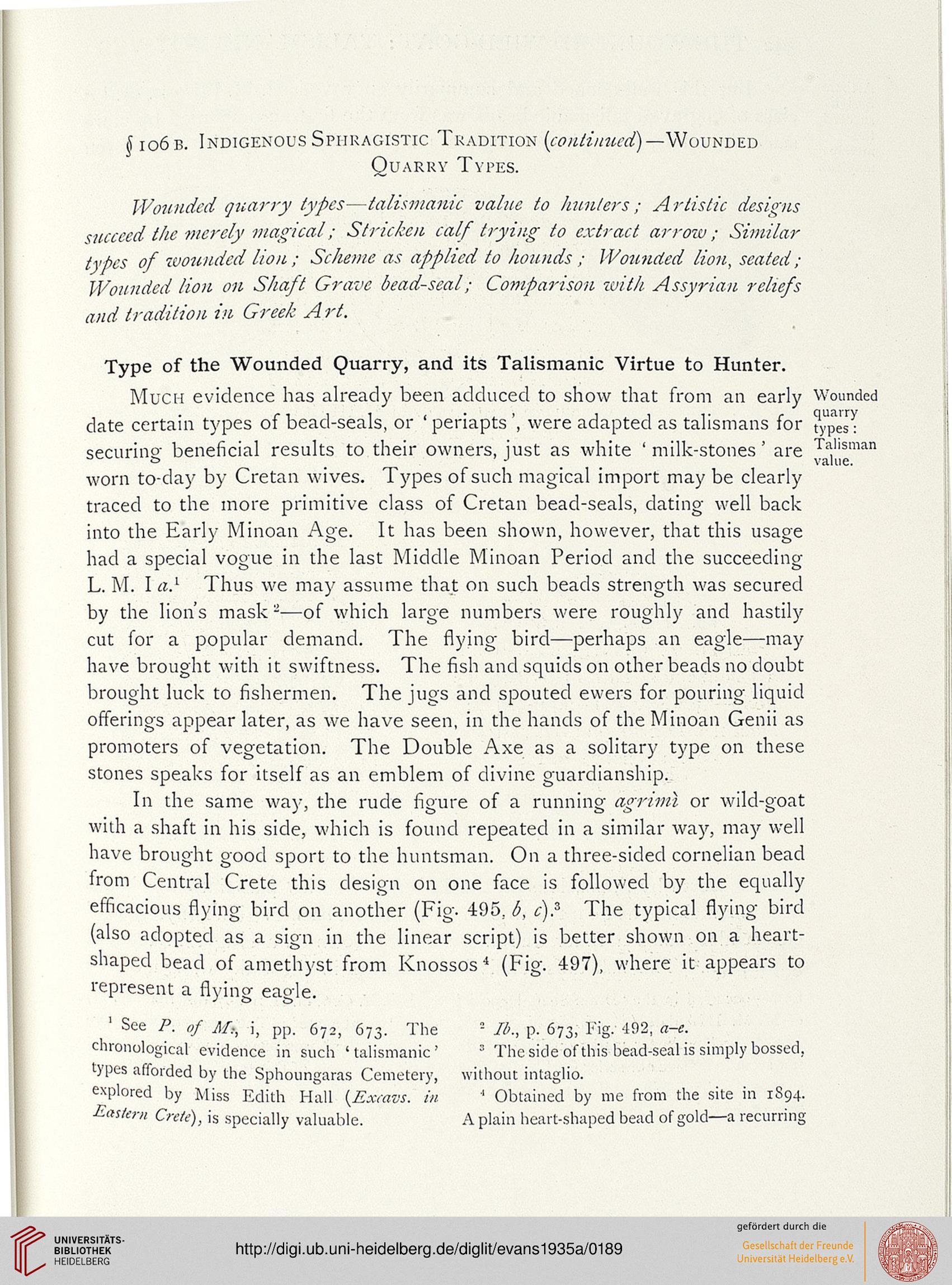value.
5106 b. Indigenous Sphragistic Tradition (continued)—Wounded
Quarry Types.
Wounded quarry types—talismanic value to hunters; Artistic designs
succeed the merely magical; Stricken calf trying to extract arrow; Similar
types of wounded lion; Scheme as applied to hounds ; Wounded lion, seated;
Wounded lion on Shaft Grave bead-seal; Comparison with Assyrian reliefs
and tradition in Greek Art.
Type of the Wounded Quarry, and its Talismanic Virtue to Hunter.
Much evidence has already been adduced to show that from an early Wounded
date certain types of bead-seals, or ' periapts ', were adapted as talismans for typjs:
securing beneficial results to their owners, just as white 'milk-stones' are ™,'™an
worn to-day by Cretan wives. Types of such magical import may be clearly
traced to the more primitive class of Cretan bead-seals, dating well back
into the Early Minoan Age. It has been shown, however, that this usage
had a special vogue in the last Middle Minoan Period and the succeeding
L. M. I a} Thus we may assume that on such beads strength was secured
by the lion's mask 2—of which large numbers were roughly and hastily
cut for a popular demand. The flying bird—perhaps an eagle—may
have brought with it swiftness. The fish and squids on other beads no doubt
brought luck to fishermen. The jugs and spouted ewers for pouring liquid
offerings appear later, as we have seen, in the hands of the Minoan Genii as
promoters of vegetation. The Double Axe as a solitary type on these
stones speaks for itself as an emblem of divine guardianship.
In the same way, the rude figure of a running agrimi or wild-goat
with a shaft in his side, which is found repeated in a similar way, may well
have brought good sport to the huntsman. On a three-sided cornelian bead
from Central Crete this design on one face is followed by the equally
efficacious flying bird on another (Fig. 495, 5, c)r The typical flying bird
(also adopted as a sign in the linear script) is better shown on a heart-
shaped bead of amethyst from Knossos * (Fig. 497), where it appears to
represent a flying eagle.
' See P. „f M,, i, pp. 672, 673. The "■ lb., p. 673, fig. 492, a-e.
chronological evidence in such 'talismanic' '' The side of this bead-seal is simply bossed,
types afforded by the Sphoungaras Cemetery, without intaglio.
explored by Miss Edith Hall (Excavs. in • Obtained by me from the site in 1S94.
Eastern Crete), is specially valuable. A plain heart-shaped bead of gold—a recurring
5106 b. Indigenous Sphragistic Tradition (continued)—Wounded
Quarry Types.
Wounded quarry types—talismanic value to hunters; Artistic designs
succeed the merely magical; Stricken calf trying to extract arrow; Similar
types of wounded lion; Scheme as applied to hounds ; Wounded lion, seated;
Wounded lion on Shaft Grave bead-seal; Comparison with Assyrian reliefs
and tradition in Greek Art.
Type of the Wounded Quarry, and its Talismanic Virtue to Hunter.
Much evidence has already been adduced to show that from an early Wounded
date certain types of bead-seals, or ' periapts ', were adapted as talismans for typjs:
securing beneficial results to their owners, just as white 'milk-stones' are ™,'™an
worn to-day by Cretan wives. Types of such magical import may be clearly
traced to the more primitive class of Cretan bead-seals, dating well back
into the Early Minoan Age. It has been shown, however, that this usage
had a special vogue in the last Middle Minoan Period and the succeeding
L. M. I a} Thus we may assume that on such beads strength was secured
by the lion's mask 2—of which large numbers were roughly and hastily
cut for a popular demand. The flying bird—perhaps an eagle—may
have brought with it swiftness. The fish and squids on other beads no doubt
brought luck to fishermen. The jugs and spouted ewers for pouring liquid
offerings appear later, as we have seen, in the hands of the Minoan Genii as
promoters of vegetation. The Double Axe as a solitary type on these
stones speaks for itself as an emblem of divine guardianship.
In the same way, the rude figure of a running agrimi or wild-goat
with a shaft in his side, which is found repeated in a similar way, may well
have brought good sport to the huntsman. On a three-sided cornelian bead
from Central Crete this design on one face is followed by the equally
efficacious flying bird on another (Fig. 495, 5, c)r The typical flying bird
(also adopted as a sign in the linear script) is better shown on a heart-
shaped bead of amethyst from Knossos * (Fig. 497), where it appears to
represent a flying eagle.
' See P. „f M,, i, pp. 672, 673. The "■ lb., p. 673, fig. 492, a-e.
chronological evidence in such 'talismanic' '' The side of this bead-seal is simply bossed,
types afforded by the Sphoungaras Cemetery, without intaglio.
explored by Miss Edith Hall (Excavs. in • Obtained by me from the site in 1S94.
Eastern Crete), is specially valuable. A plain heart-shaped bead of gold—a recurring





